LINKING SEQUENCES TO BE MORE COMBAT EFFICIENT
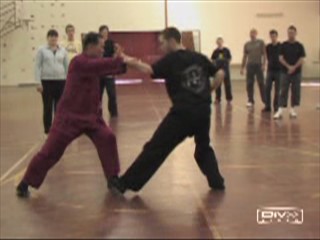
How you may continue with a combat sequence after the first combat sequence is completed
Why do many kungfu practitioners who can perform beautiful kungfu patterns in solo abandon their kungfu for free-style fighting, Kick-Boxing or other martial techniques when they spar?
There are a few reasons. The main reason is that they have never been trained to use kungfu techniques in sparring. They have only been trained to perform kungfu patterns in solo. So when they spar, they are forced to use kungfu patterns haphazardly, instead of in a systematically trained manner.
For example, when an opponent throws them a punch, irrespective of whether it is a typical kungfu punch or a clumsy punch from an untrained person, the kungfu practitioners start thinking what kungfu techniques they could use against the punch. If they are lucky to ward off the punch with some kungfu techniques, their opponent now throws them a kick.
They then start thinking of what kungfu techniques to use next. And before they realize what has happened, a torrent of punches and kicks would rain on them. In frustration they would throw away their kungfu forms and fight randomly like their opponent. They would find using kungfu forms a burden, whereas fighting randomly would be more effective.
This is true, but they do not know the true reason. The true reason is not that kungfu forms are ineffective for fighting, but that they have never been trained to use them. Because kungfu forms are sophisticated, to untrained persons they would become a liability rather than an asset.
Let us take an analogy. If you compare walking to riding a bicycle, riding a bicycle is faster But if you do not know how to ride a bicycle, the bicycle becomes a liability rather than an asset, in which case you would be faster by throwing away your bicycle and walk instead.
It is the same with kungfu. But kungfu is not merely a bicycle, it is a car. A skillful person by walking or running can still be faster than someone riding a bicycle, but he will never be faster than a car. Just like a car can give you many other benefits besides enabling you to reach your destination faster, practicing kungfu can also give you many other benefits besides making you more combat efficient.
The video series below follows from the previous one. It shows you how you can link combat sequences together to enable you to be more effective in sparring or actual fighting.
Continuing from a Combat Sequence
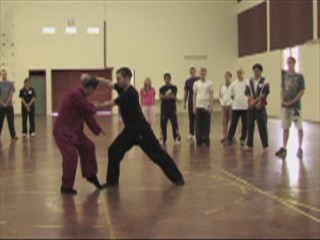
In our sparring methodology, after an initiator has completed a sequence, he or the responder may continue with another sequence. Here the responder makes the continuation, he uses the same sequence, Sequence 4, the initiator uses. Notice the combat skills involved in the encounter.
Solo Practice of Sequences

A common question many students ask is how they can practice combat application if they do not have a sparring partner. A good way is to practice combat sequences, or a selected part of a combat sequence. You can practice a part of Combat Sequence 4 to be so skillful that when you match a partner or a real opponent, you can execute it flawlessly.
Have Fun rather than Injuries in Sparring
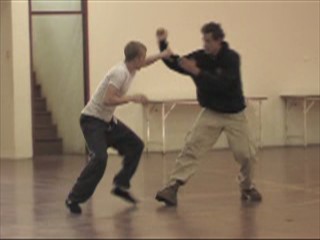
To have some variety, here Nick and George engage in some free sparring where they need not follow any combat sequences. Notice that they use stances and kungfu patterns, and not bouncing about or free-style fighting. More significantly they do not hurt each other, and both have much fun.
Footwork in Continuing a Sequence
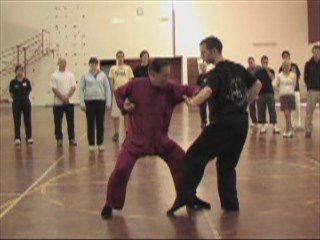
You need to make some footwork adjustment if you wish to continue another sequence after you have completed a sequence. For example, if you complete your first sequence in the left leg mode, and wish to continue with another sequence which starts with the right leg mode, you have to make some footwork adjustment. The responder may also have to make footwork adjustment.
Alternative Footwork of Responder
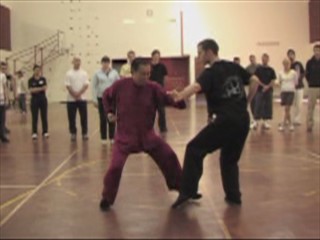
This video clip shows an alternative footwork adjustment employed by a responder. Instead of stepping back from a left False-Leg Stance to a right False-leg Stance and then readjust to a left Bow-Arrow Stance, as shown in the previous video clip, he can just glide back from a left False-Leg Stance to also a left False-Leg Stance, and then move forward to a left Bow-Arrow Stance to continue the next sequence.
Continuing a Sequence by Responder
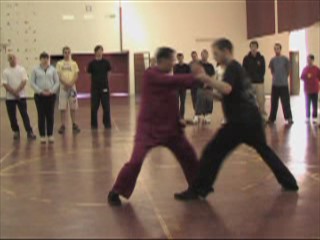
Earlier it was the initiator who continued from a combat sequence. Here the responder, instead of the initiator, continues with a second sequence after the first sequence.
Transitional Footwork Between Sequences
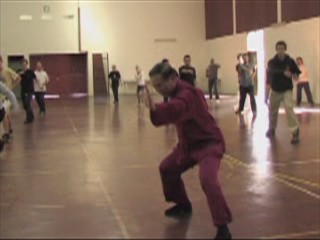
The transitional footwork is used to link the end of one sequence (which ends with a left Bow-Arrow Stance) with the start of the next sequence (which also starts with the left Bow-Arrow Stance). This applies in the case of a responder completing any one of the Sequences 1 to 4, and continuing with any one of the Sequences 1 to 4. It is important to cover the opponent before continuing with the next sequence.
The Continuation Stage in our Sparring Methodology
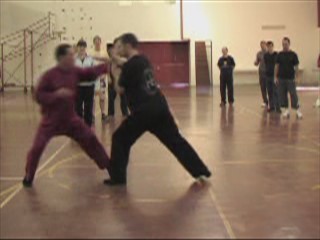
There are various steps in our sparring methodology. In our combat sequence training, we start with “pre-choice”, then move to “self-choice”. Then we move to “continuation” where an initiator or a responder may continue with a new sequence after the first sequence is over. Correct footwork is required for smooth continuation.
Opening or Closing an Opponent's Hand

It is important to ask the way so as to prevent the opponent counter-striking when you continue with the second sequence. You may "open" or "close" the opponent's hand while asking the way.
Using Kungfu Forms in Sparring

Participants practice the continuation stage in our sparring methodology, where an initiator or a responder continues with a second combat sequence after the first combat sequence is completed. This is a good way to develop combat skills like fluid movements and spontaneous response, besides the basic skills of correct spacing and correct timing. Most significantly, they can use kungfu forms in their sparring.
Overcoming a Major Problem of Many Martial Artists

In our sparring methodology, we call this method “continuation”. By following this method, you overcome a major problem faced by many martial artists while sparring or fighting, i.e. they do not know what move to use next after each move.
Changing Leg-Mode in Continuing another Sequence
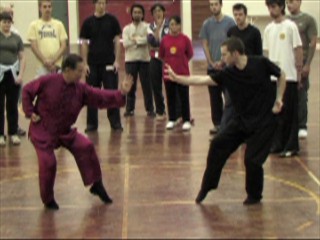
What should you do if you complete your first sequence with one leg in front and you have to start the next sequence with another leg in front? Simple. Just change your leg-mode, as shown in the video.
Sparring within a Framework of Conditions
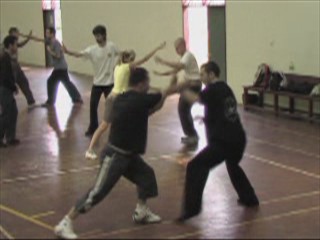
By employing this method of continuation, participants are able to use kungfu forms for sparring. Within a framework of conditions, participants have some choice. They can start with any one of Sequences 1 to 4, and either one can continue with any one of the four sequences. A hallmark is that no one is hurt and they enjoy themselves.
LINKS
Review of the Intensive Shaolin Kungfu Course in Sabah in March 2007
- Overview 1 : The Fundamentals
- Overview 2 : The 16 Combat Sequences
- Overview 3 : Are They Performing Kungfu Dance?
- The Basics of Shaolin Kungfu Training
- Fundamental Combat Skills
- Defeat you Hand to your Opponent, Victory you Create Yourself
- Avoiding Disadvantages and Seeking Advantages
- Basic Principles and Tactics of Combat
- Skills derived from Sparring can be Rewardingly used in Daily Life
- Some Secrets in Practicing Genuine Kungfu
-
Various Ways to Move into an Opponent
- Applying Combat Sequences in Sparring
- Linking Sequences to be More Combat Efficient
- The Secrets of Continuous Cannons
- The Mechanics of Continuation
- Marvelous Techniques Beget Marvelous Techniques
- Perfecting Forms and Developing Force
- Applying Tactics in Combat
-
Objectives of Form Training in Solo
- Being Fluent in Kicking Techniques before Applying them in Combat
- Using Tactics in Kicking Attacks and Defences
- Different Levels of Sophistication in Sparring and Fighting
- The Legacy of Uncle Righteousness: Secret of Continuous Cannons and their Counters
-
Benefiting from the Experiences and Teachings of Past Masters
- Poetic Patterns Can be Very Deadly
- Moving Back One Step when in Diffiuclt Situations
- Linking Sequences to Form a Kungfu Set
- Felling Techniques in Kungfu are Different from Judo and Wrestling
- Butterfly Palms and Hiding Flowers are Excellent in Countering Felling and Gripping Attacks
-
Let Mercy Flow from the Hands
- Benefits of Solo Set Practice — Combat Sequences 13 to 16
- From Pre-Choice Sequences to Free Sparring
- Applying Shaolin Patterns Correctly and Spontaneously in Free Sparring
- Shaolin Kungfu against Boxing and Kick-Boxing
- Shaolin Counters against Wrestling Shoots
- The Secret of Grandmaster Ho Fatt Nam
- Why Shaolin Kungfu is Technically Faster than Boxing
- Shaolin Techniques, Tactics and Strategies against Boxing
- Revealing Secrets of Past Taijiquan Masters
- Overwhelming Opponents with Just One Pattern
- Poetry and Elegance in Effective Combat
